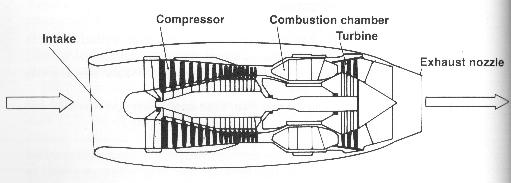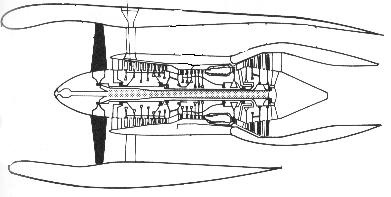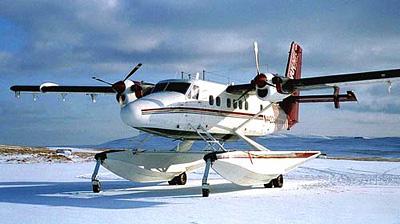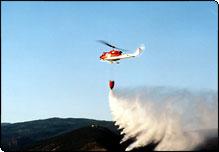Types of Jet Engines
The types of jet engines include:
-
Turbojet
-
Turbofan
-
Turboprop
-
Turbo shaft
Turbojet

Image taken from Jet Engines
The turbojet is the simplest of them all, it is just as
described in "The basics" section. This style was the first type
of jet engine to be used in aircraft. It is a pretty primitive style
used mostly in early military jet fighters such as the F-86. Its
use was discontinued, for the most part, in favor of the more efficient
turbofans. Actually, I should clarify that. Each type of engine
is most efficient under certain conditions. Turbojets are most efficient
at high altitudes and speeds above the speed of sound. See the diagram
at the end of this page for relative efficiencies of each style engine.
Turbofan

Image taken from Jet Engines
Turbofans make up the majority of jet engines being produced
and used today. A turbofan engine uses an extra set of turbine blades
to drive a large fan, typically on the front of the engine. This
fan differs from a propeller in that there are many small blades and they
are inside of a duct. The fan sits just in front of the normal intake,
some of the air driven by this fan will enter the engine, while the rest
will go around the outside. The amount of air that bypasses the engine
is different for each type of airplane. The different styles are
called high and low bypass engines. Bypass ratio is the ratio of
how much air goes through the fan, to how much goes through the engine.
Typical bypass ratios would be 1:1 for a low bypass and 5:1 or more for
a high bypass. Low bypass engines are more efficient at higher speeds,
and are used on planes such as military aircraft, while high bypass engines
are used in commercial airliners.
Turboprop

Image taken from http://www.ebushpilot.com
Turboprops are similar to turbofans in that they incorporate
an extra set of turbine blades used to drive the propeller. Unlike
the turbofan engines, nearly all the thrust produced by a turboprop is
from the propellor, hardly any thrust comes from the exhaust. These
engines are used mostly on smaller and slower planes such as commuter aircraft
that fly to the smaller airports. As you can see from the efficiency
chart below, turboprops are very efficient over a fairly wide range of
speeds. They would probably be used more often on large transport
aircraft, except for one problem: they have propellors. The
general public does not like propellors, as they appear to be old-fashioned
and unsafe. However, the military knows better and uses them on several
large transport aircraft.
Turbo shaft

Image taken from http://www.wildcathelicopters.com
Turbo shaft engines are very similar to turboprop engines,
but instead of driving a propellor, they are used to drive something else.
Many helicopters use them to drive their rotors, and airliners and other
large jets use them to generate electricity. Also, the Alaska Pipeline
uses them at the pump stations to pump oil.
Overall
Overall the big difference between these engines is how
they take a chunk of air and move it. Newton's third law states that
Force equals mass times acceleration. Applying this to turbine engines:
the turboprop takes a large chunk and accelerates it a little bit, while
the turbojet takes a small chunk and accelerates the heck out of it, and
the turbofan is somewhere in between these two.
These different methods of moving air also have to do
with how much noise each engine makes. The turbojet makes the most
noise because there is a large difference in velocities of the blast of
air coming out the exhaust and the surrounding air. The air from
the fan on a turbofan engine "shields" the blast in the center by having
the slower moving air from the fan surround it. Then the turboprop
is the quietest of all because the air it's moving is relatively slow.




